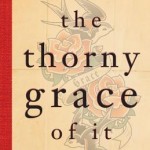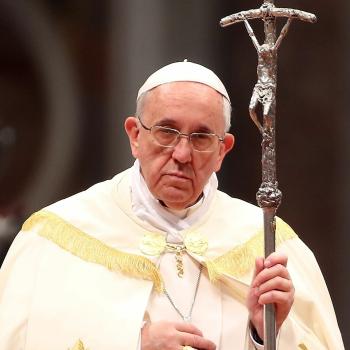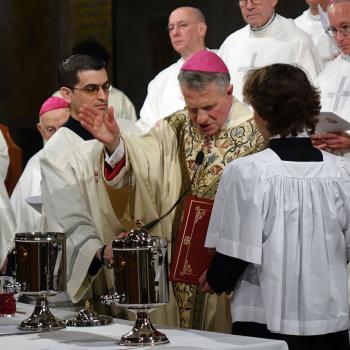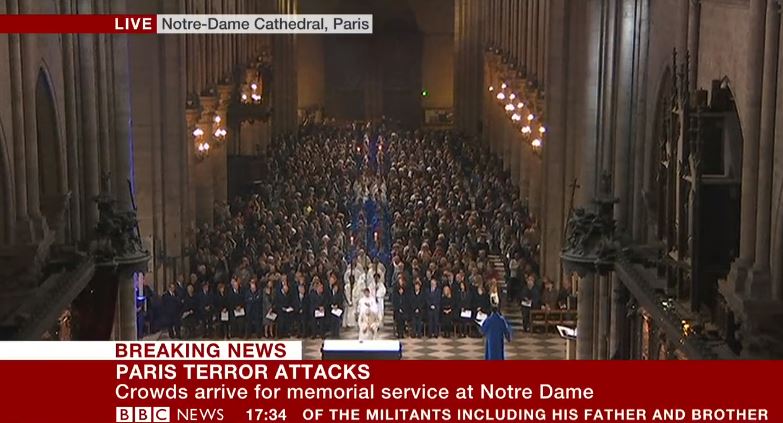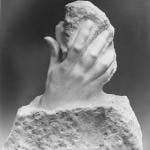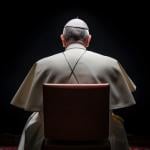 Detroit’s historic St. Josaphat Church, which dates back to 1901, suffered serious damage in the storm which blasted through the area on November 17. A breaking story by Mike Stechschulte in The Michigan Catholic shows the badly damaged main steeple tilting in the wind.
Detroit’s historic St. Josaphat Church, which dates back to 1901, suffered serious damage in the storm which blasted through the area on November 17. A breaking story by Mike Stechschulte in The Michigan Catholic shows the badly damaged main steeple tilting in the wind.
Located on East Canfield along the I-75 service drive just north of downtown, St. Josaphat is one of Detroit’s most visible Catholic landmarks. The Archdiocese of Detroit’s 300-year anniversary commemorative book, Make Straight the Path, features its three steeples photographed with Detroit’s Renaissance Center towers in the background.
 Soon, though, there may be only two steeples. The damage inflicted to the 200-foot main steeple by 60-mph wind gusts leaves many wondering whether the lilting spire can be repaired.
Soon, though, there may be only two steeples. The damage inflicted to the 200-foot main steeple by 60-mph wind gusts leaves many wondering whether the lilting spire can be repaired.
St. Josaphat’s history is interwoven with the history of Detroit. The parish was founded in June 1889, and the first combination church and school building was dedicated in 1890. Within ten years, though, the growing parish planned a new church, rectory and convent.
In 1982, the church was included on the National Register of Historic Places. In recent years, however, St. Josaphat has faced declining attendance, as the Catholic population moved northward toward the suburbs. In 2003, it was clustered with two other beautiful Detroit churches—Sweetest Heart of Mary, and St. Joseph. In 2004, St. Josaphat gained new prominence when it became the first church in the Archdiocese of Detroit to regularly celebrate the Tridentine Latin Mass.
This year, on June 13, 2013, Archbishop Vigneron issued a decree creating a new parish, Mother of Divine Mercy Parish, which encompasses the three historic churches in one worshipping community.
* * * * *
St. Josaphat was one of the parishes I profiled in my review of Detroit’s Historic Places of Worship, a new book published by Wayne State University Press.
More information is available on Mother of Divine Mercy Parish’s website, which includes historical descriptions of St. Josaphat and the other clustered parishes. From the parish’s website, a look at the art of the Victorian Romanesque style church:
All of the sacred images of the church are illuminated by a myriad of tiny light bulbs. The church was originally built with both gas and electric which can be seen by observing the fixtures throughout the church At the turn of the century there was a great fascination with the electric light bulb which is clearly witnessed in St. Josaphat Church.
The interior of the church features five beautiful altars. The main altar is centered around a painting of the patron of the parish, St. Josaphat dressed in the vestments of an eastern rite bishop. This painting can also be raised to reveal a beautiful image of Our Lady of Czestochowa, the “Black Madonna”. On either side of the central image are figures of Ss. Stanislaus Kostka and Aloysius Gonzaga.
The side altars in the sanctuary are dedicated to the Blessed Virgin Mary and St. Joseph. They also feature figures of Ss. Joachim and Anne and Ss. Peter and Paul. In the transept of the church are altars dedicated to Ss. Anthony of Padua and Francis of Assisi. Figures of St. Clare and St. Theresa of Avila are also found there.
The stained glass windows feature Mary and Joseph and the twelve apostles. The woodwork throughout the church is white oak.
Throughout the church a beautiful collection of murals can be seen on the ceiling and walls. Above the high altar the Most Holy Trinity is pictured. On the left and right of this are the Nativity and the Last Supper. The Resurrection is also portrayed. On the side walls of the sanctuary are murals of a Pilgrimage to Czestochowa and a Battle during World War I between Polish and Russian forces. The Poles were victorious due to the miraculous intercession of the Blessed Virgin Mary.
The central transept of the church features images of the four evangelists. Over the nave of the church is a unique image of Mary the Queen of Poland surrounded by the saints of Poland. Other images to be found are Holy Family, St. Cecilia, and Christ and the children.
Above the four confessionals are murals depicting the expulsion of Adam and Eve from the garden of paradise, St. Peter’s denial of Christ, the return of the prodigal son and Mary Magdalene drying Christ’s feet with her hair.

